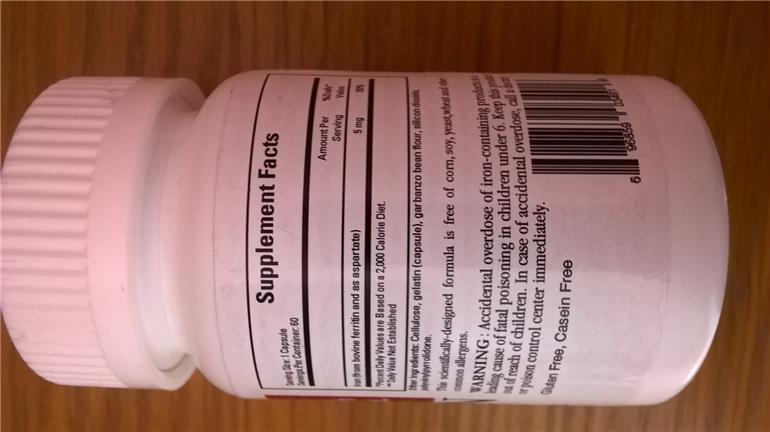Any ideas please ...? Hope this is a good place to ask this question. I'm hypothyroid after RAI, and take 175 levo. I've had awful fatigue for 15 months. My ferritin is low in range, 58 (range 23 - 300) But all other blood results are good eg hb, folate, Vit D, B12. I feel I'm not converting to T3 well enough. T4 = 20 (8.0 - 21.0); T3 = 3.7 (3.8 - 6.0); TSH 0.03 (0.35 - 3.5) I'd like to raise my ferritin to help this. I've found this Ferritin product; wonder it would be good to raise my ferritin, maybe without raising hb level?
Ferritin product: Any ideas please... - Pernicious Anaemi...
Ferritin product

The product is described as 'Iron from bovine ferritin' which suggests to me that it doesn't actually contain ferritin. Instead it contains iron aspartate. Whether this would be any better than the myriad other forms of iron supplementation I've no idea. But if they're trying to pretend it is ferritin, then I'd give them a wide berth.
Ferritin would be pointless in a tablet as it's a protein. Proteins can't be absorbed from the gut, instead they're taken apart by enzymes. That's why insulin (another protein) is no good in tablet form.
It appears that we (humans) do have actually have mechanism for taking in ferritin from our guts - and that mechanism is separate to those by which we can absorb haem (heme) and iron salts.
Looks to me as if maximal iron absorption might be achieved by taking ferritin, haem and iron salts - possibly separately in the day, but concurrently.
Have a read - the full paper is available in PubMed Central:
J Nutr. 2012 Mar;142(3):478-83. doi: 10.3945/jn.111.145854. Epub 2012 Jan 18.
Absorption of iron from ferritin is independent of heme iron and ferrous salts in women and rat intestinal segments.
Theil EC1, Chen H, Miranda C, Janser H, Elsenhans B, Núñez MT, Pizarro F, Schümann K.
Author information
Abstract
Ferritin iron from food is readily bioavailable to humans and has the potential for treating iron deficiency. Whether ferritin iron absorption is mechanistically different from iron absorption from small iron complexes/salts remains controversial. Here, we studied iron absorption (RBC (59)Fe) from radiolabeled ferritin iron (0.5 mg) in healthy women with or without non-ferritin iron competitors, ferrous sulfate, or hemoglobin. A 9-fold excess of non-ferritin iron competitor had no significant effect on ferritin iron absorption. Larger amounts of iron (50 mg and a 99-fold excess of either competitor) inhibited iron absorption. To measure transport rates of iron that was absorbed inside ferritin, rat intestinal segments ex vivo were perfused with radiolabeled ferritin and compared to perfusion with ferric nitrilotriacetic (Fe-NTA), a well-studied form of chelated iron. Intestinal transport of iron absorbed inside exogenous ferritin was 14.8% of the rate measured for iron absorbed from chelated iron. In the steady state, endogenous enterocyte ferritin contained >90% of the iron absorbed from Fe-NTA or ferritin. We found that ferritin is a slow release source of iron, readily available to humans or animals, based on RBC iron incorporation. Ferritin iron is absorbed by a different mechanism than iron salts/chelates or heme iron. Recognition of a second, nonheme iron absorption process, ferritin endocytosis, emphasizes the need for more mechanistic studies on ferritin iron absorption and highlights the potential of ferritin present in foods such as legumes to contribute to solutions for global iron deficiency.
PMID:
22259191
[PubMed - indexed for MEDLINE]
PMCID:
PMC3278266